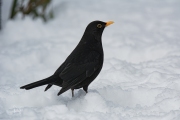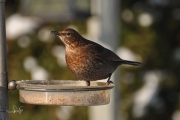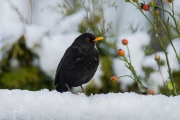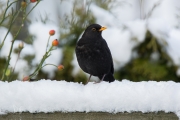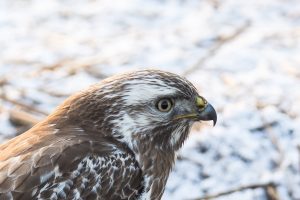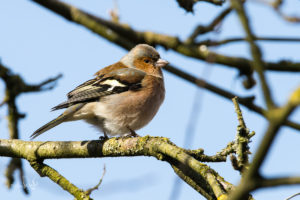Did you participate in the Big Garden Birdwatch at the end of January? Or does that take place at a different time in your country or perhaps there is no such event organized? In my previous English blog about the chaffinch (Fringilla coelebs) I wrote that in many countries garden birds are counted every year. Of course I participated again this year with a nice result. The great tit (Parus major) and blue tit (Cyanistes caeruleus) were at the top for me, followed by the house sparrow (Passer domesticus). The chaffinch finished in fourth place and the greenfinch (Chloris chloris) was fifth. Sixth place went to the brambling (Fringilla montifringilla). The blackbird (Turdus merula) finished in seventh place for me, together with the great spotted woodpecker (Dendrocopos major) and the long-tailed tit (Aegithalos caudatus). And this blog is about the blackbird.
Bird of the Year
Since 2002 every year a “Bird of the Year’’ has been selected by Sovon Vogelonderzoek Nederland (Dutch Centre for Bird Research) and Vogelbescherming Nederland (Dutch Bird Conservation Association). The species that are selected are ones that need extra research to aid their conservation. In the first year 2002 it was the kingfisher (Alcedo atthis) and furthermore include the wheatear (Oenanthe oenanthe) in 2005, the oystercatcher (Haematopus ostralegus) in 2008, the barn swallow (Hirundo rustica) in 2011 and the house martin (Delichon urbicum) in 2018 and 2020 it was the mallard (Anas platyrhynchos); a fairly common species, after all, who doesn’t know it? In recent years, however, this species has been declining in numbers in for unclear reasons. Partly due to the coronavirus there was no Bird of the Year in 2021, but Sovon and Vogelbescherming have started preparations for 2022. The year in which the blackbird has a place in the spotlights.
Gone from the top three
And that’s not without reason. Just like the mallard, the blackbird is doing extremely badly in the Netherlands. This bird is one of the most common species in our country and can be found almost everywhere in gardens and parks. Since 2007 however, the numbers has been declining slightly and since 2016 the species has been going downhill alarmingly fast. In a span of several years, the breeding population has decreased by almost 30 percent. This decrease is also clearly visible in the results of the National Garden Bird Count in our country. The blackbird had been in third place for fifteen years after the eternal numbers one, the house sparrow and two, the great tit, until 2017. That year, the blackbird dropped to the fifth place and has since literally hopped between fourth and fifth in the tally.
Usutu virus
The decline in the number of blackbirds has two probable causes. First of all, the usutu virus that emerged in the Netherlands in 2016. This virus has its origin in Africa and is transmitted by mosquitoes. It infects birds and mammals and although you don’t hear much about it, it can also infect humans. Especially in the elderly and people with immune disorders, the virus can cause a severe disease course, which is accompanied by fever, headache and skin rash. In the worst case, it can cause meningitis. In birds, infection with the virus is often fatal and blackbirds in particular are severely affected. The virus was first discovered outside Africa in 2001, in Austria, where it caused a real onslaught among the blackbirds. Subsequent investigations showed that the virus was thought to have been responsible for a large bird death in Tuscany as early as 1996.
Mild winters
A second probable cause lies in the changes in the climate. Because although you wouldn’t say it right away, blackbirds are also migratory birds. As soon as it gets really cold in the Netherlands, “our” blackbirds move south. It may not be that noticeable, because their place is taken by birds from Northern Europe, which in turn come here to spend the winter. Our winters have not been so harsh in recent years, so many blackbirds don’t migrate southward, but stay here and they are supplemented with birds from Scandinavia. The number of blackbirds in winter was therefore generally higher here than in summer. In recent years, however, the winters in Northeastern Europe are no longer what they used to be and so many birds stay there. So on balance you arrive at a lower number of blackbirds in the garden bird count in January. Then also subtract the number of victims of the usutu virus and you immediately understand why the numbers have decreased in recent years.
Happy singer
Fortunately, despite these pessimistic signals, we don’t have to miss the blackbird yet. Because as soon as spring starts to come, the male sings from a high place with its beautiful whistling and rolling song. Sometimes for hours at a time. The blackbird males sing to defend their territory and – of course – to lure females. They have a very extensive repertoire and their singing is very recognizable. And if they don’t sing, you will hear the alarm call when danger threatens. Blackbirds have different calls with which they warn each other. They also distinguish between danger from the ground (for example a cat) and in the air (for example a sparrowhawk). Just pay attention if you hear a blackbird alarming the moment a cat sneaks through the garden.
In our garden I sometimes see six to eight blackbirds. Foraging, singing, sometimes they chase each other. The males are easily recognizable by their deep black plumage with the bright orange bill. The females are dark brown with a somewhat lighter breast and their bill is less striking. Young blackbirds, especially the males, have a dark-colored bill up to and including their first winter.
Hemerophile
Blackbirds are, incidentally, originally real forest birds. Until the mid-nineteenth century, the bird led a secluded life in dense deciduous forests, from which they barely escaped. They didn’t want to have anything to do with people (don’t blame them ;-)), stayed far away from them and only in winters with very heavy snowfall the blackbirds would visit the towns. At some point, they began to seek out the human environment more and more often, and it was only in the early twentieth century that the bird was widely seen in towns and cities. The blackbird is therefore really a typical example of a hemerophile: they make grateful use of the possibilities offered by us humans. For example, because there is often enough to eat in the gardens. Earthworms, snails and insects can be found in the lawns and the birds are often provided with extra food in winter (but also all year round). Blackbirds are true omnivores.
PhD research
Blackbirds have therefore adapted particularly well to the human environment. This adjustment also has other consequences. In December 2009, behavioral biologist Erwin Ripmeester obtained his doctorate from the University of Leiden for his research into the comparison between urban and forest blackbirds. He came to the conclusion, among other things, that the intervals in the song of the city blackbirds were shorter than with their congeners in the forest. This is because there are more blackbirds per surface area in the city than in the forest. So to ensure that they do stand out from the females, they should sing as much as possible and therefore pause as little as possible. In addition, the urban blackbirds also seem to sing some octaves higher than their forest companions. And they probably do that to be heard above the ambient noise of the city.
City blackbird
That wasn’t all Ripmeester discovered during his research. It also turned out that the male blackbirds in the city are heavier and sometimes also have shorter bills and legs. And it goes one step further. There was also a difference in the DNA of the urban and forest blackbirds. In other words, the urban and forest blackbirds evolve side by side and there is less and less genetic exchange. Perhaps in a few decades there will be a new subspecies: the urban blackbird (Turdus merula domestica?). This isn’t a joke. For example, look at the domestic and feral pigeon (Columba livia domestica). These pigeons are descendants of the wild rock dove (Columba livia). This ancestral wild pigeon that does not occur in the Netherlands but domesticated animals of this species eventually, after generations of selected breeding, gave rise to, among other things, the homing pigeon. Populations of feral pigeons originate from escaped domesticated (i.e. kept by humans) pigeons. The blackbird however, is not a domesticated species, but it shows a development that is partly the result of human influence.
Many youngsters
Although the blackbird population is under so much pressure, the bird still manages to maintain itself. This is not least because the bird has two to sometimes four clutches per year. Each clutch consists of four to five eggs and in a good year as many as six. So they can raise a lot of youngsters. After fledging, the young birds are cared for by the male in particular for another two to three weeks, while the female has already started a new brood. Of course, many young do not make it to adult birds. This is especially due to predation by for example cats but corvids and even woodpeckers too know where to find the eggs and young.
The tide seems to have turned
Fortunately, the tide seems to be turning for the blackbird. At least this year. Because after five years, the bird in 2022 has returned to the top three in the Big Garden Birdwatch in the Netherlands. Hopefully the recovery of the blackbird population has now started and we can continue to enjoy this beautiful cheerful singer for a long time to come.
Bronnen (in Dutch)
This item was originally published in Dutch on January 28th 2022.



